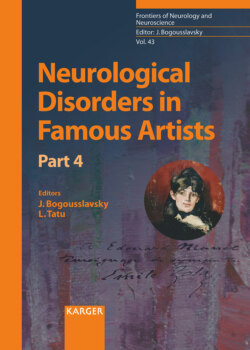Читать книгу Neurological Disorders in Famous Artists - Part 4 - Группа авторов - Страница 29
На сайте Литреса книга снята с продажи.
The Radial Nerve Surgery
ОглавлениеAccording to a letter written by one of his Hazebrouck hospital nurses, Alice David (1874–1943), with whom he had an intimate relationship, Céline should have been operated for his radial paralysis at the Val-de-Grâce hospital [letter from Alice David of December 29th, 1914; Céline, 2009, p. 130]. He refused the procedure, probably fearing an amputation.
Fig. 2. Louis-Ferdinand Destouches (with his Médaille militaire) with Albert Milon (with crutches) in the Val-de-Grâce Hospital (Paris), December 1914 (public domain).
On December 27th, 1914, Céline was transferred from the Val-de-Grâce hospital to the hôpital auxiliaire 47 located on boulevard Raspail in Paris, where he refused again the surgical procedure suggested by Doctor Édouard Le Bec (1851–1941) [Gibault, 1985, pp. 157–164]. He was then rapidly sent to Paul-Brousse Hospital in Villejuif on December 31st. Albert Milon made the same journey and was admitted with Céline in Paul-Brousse Hospital (Fig. 3).
There, Prof. Gustave Roussy (1874–1948) convinced Céline to accept the operation. He underwent surgery on January 19th, 1915 [Archives du Service de santé des armées, 1915]. The surgical procedure was performed by the renowned Prof. Antonin Gosset (1872–1944): “The exploration of the area was done through an oblique incision on the dorsal side of the arm. The section of the radial nerve was confirmed. Both sectioned ends were located in the tissues. There was a neuroma on the upper end. Both ends were dissected and a suture was performed. A large callus was removed and a muscle flap was inserted between the nerve and the humerus” [Ducourneau, 1966; Gibault, 1985, pp. 157–164].
Fig. 3. Louis Destouches and Albert Milon appear in the records of Paul-Brousse Hospital, held by Prof. Gustave Roussy (Archives du Service de Santé des Armées, Val-de-Grâce, Paris).
The operation did not seem to produce the expected results. The nurse Alice David wrote 3 weeks after the surgery: “I wish had received better news. I hoped the intervention would have better results! But I do not lose faith, and I will pray for it” [letter from Alice David of February 9th, 1915; Céline, 2009, p. 134].
On February 22nd, 1915, Céline left the Paul-Brousse Hospital. Roussy’s medical report specified: “Extension of the hand and first phalanges is nonexistent as well as extension and abduction of the thumb. There is a slight forearm atrophy and the landmark of the brachioradialis muscle is missing” [Ducourneau, 1966; Gibault, 1985, pp. 157–164].
Céline needed electrical treatment to stimulate the recovery of his right radial nerve. He was sent to the Hôpital Michelet in Vanves, where he underwent this treatment in February and March 1915. The report of the electrical exploration carried out on March 16th, 1915, showed the absence of electrical excitability for the extensor digitorum and pollicis muscles and a reduced excitability for the triceps brachialis and brachio-radialis muscles. The conclusion suggested that some galvanic shock sessions were still necessary [Institut Mémoire de l’Édition Contemporaine, 2009].
In March 1915, Céline received a convalescence leave. In May 1915, his new affectation was the French Consulate in London. Adopted in August 1915 in France, the Dalbiez law in France compelled convalescing soldiers to be reevaluated by a medical military commission to determine their fighting abilities. Céline was examined by the medical doctor of the French Consulate in September and December 1915 and was officially discharged with a réforme No. 2 [Archives de Paris, 1914]. In April 1917, during his stay in Cameroun, Céline was re-examined by the chief doctor of the hospital of Douala, who specified that he was still suffering from a radial paralysis [Les Cahiers, 1978]. The long-term results of his radial nerve surgical procedure, performed 2 months after the nerve section, are unclear but seemed to be limited.
In 1939, Céline asked to be examined again by a medical military commission to request a réforme No. 1, which would grant him an invalidity pension. The clinical examination confirmed: “Radial paralysis. Long intervention scar on dorsal side of arm. Paralysed extensors. Dropping hand. Severe pain reactions in the sensitive radial nerve territory triggered by hand movements” [Dauphin and Boudillet, 1977, p. 163]. He eventually obtained an invalidity pension, validated by another medical commission 3 years later.
